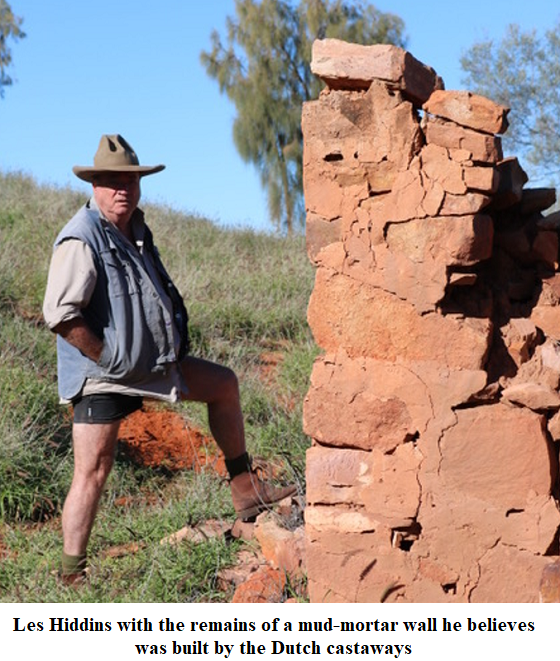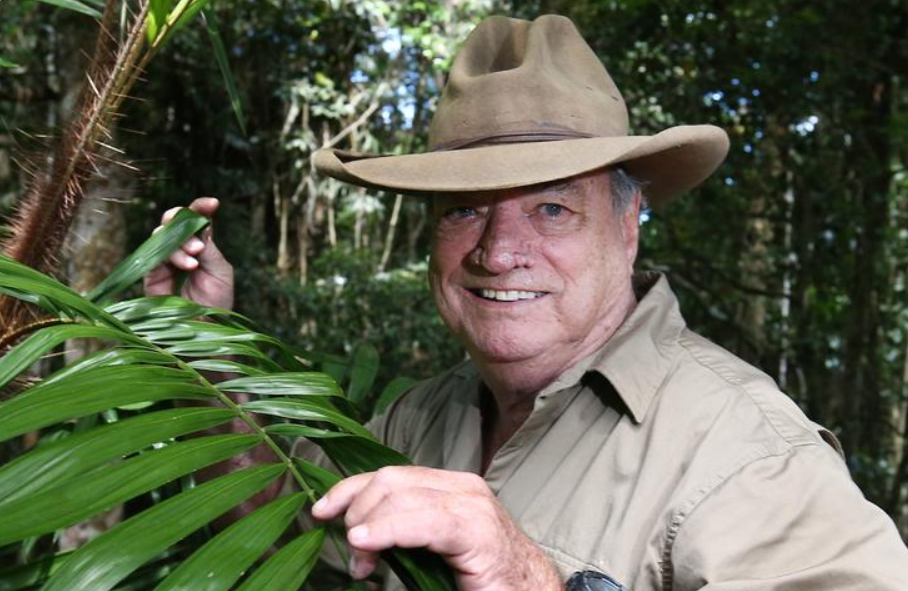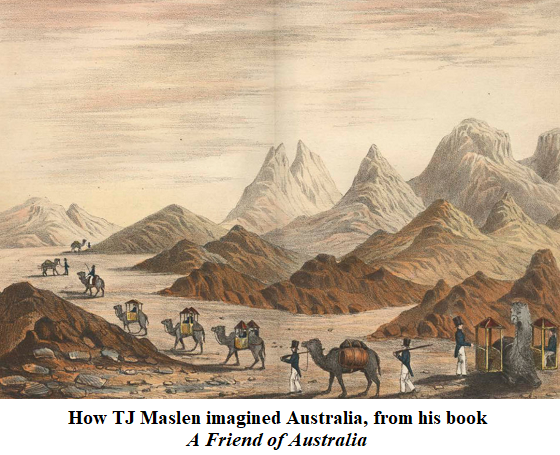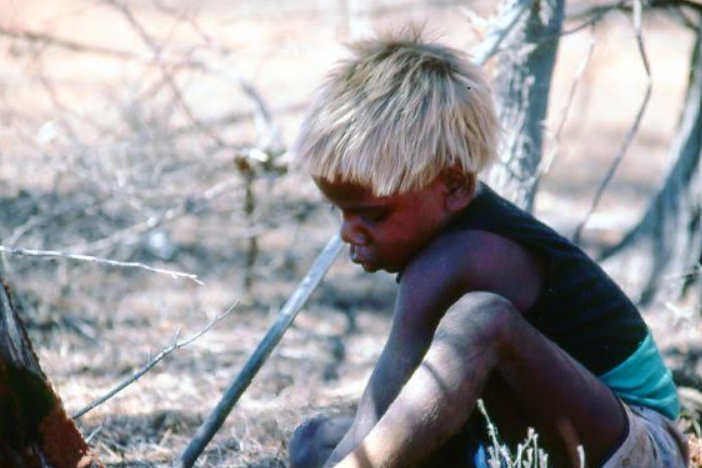
Were There Dutch Castaways in Central Australia?

Was there a colony of up to 300 Dutch people living in Central Australia from about 1710 until they died out before 1860? If that were true, a mass of Australian history would have to be re-written. To even suggest it invites the same mockery anyone gets about UFOs or finding Lasseter’s lost gold reef. And yet there is strong documentary backing for this story of a Dutch settlement in central Australia long before Captain Cook and the landing at Botany Bay.
Finding and marshalling this evidence has been the life’s work of an Australian authority on survival in bush and desert – the “Bush Tucker Man” Les Hiddins AM, of Townsville. Everyone knows how Hiddins, 76, can find edible grub and drinkable water, rather than doing a perish. But few appreciate that Hiddins is also an amateur historian whose rigour, depth of archival inquiry and savvy about the terrain leave academic historians frothing over their skinny lattes back at University House. Hiddins’ track record is here. For academics’ bogus Australian history, try here and here.
For those who don’t know of Hiddins, he is an ex-Army major who did two Vietnam deployments, the first as a forward scout. His first authorship was the 1987 Australian Army Survival Manual. On TV nature shows internationally he was of comparable stature to Steve Irwin.
If his convictions about the Dutch colony are crazy, well his interrogations of the documentary evidence might convert you too somewhat to the crazy side. Moreover, you’ll be shoulder-to-shoulder with your ABC on this. In 1996 it ran the half-hour Series 3 Episode 5 of Bush Tucker Man covering what Hiddins then knew about the colony. The ABC saw fit to repeat it unchanged four months ago, without guidance such as: “Warning. Disinformation!” Last year’s program involved his early Research 101, with many mistaken guesses. He’s now corrected those and substituted outputs based on better archival documents and intense ground and helicopter-based explorations. His work is barely half-finished: there are still more questions than answers.
I’d better add here that Hiddins’ Dutch-colony story has nothing to do with fake Aboriginal Professor Bruce Pascoe of Melbourne University and his fake “Aboriginal agriculture” compilations. Whereas our historians dance along with Pied Piper Pascoe, they won’t give five minutes to Hiddins and his 30 years of painstaking research into a massive Australian mystery.
Hiddins’ key document is a 1300-word Leeds Mercury newspaper account of January 1834, which we reproduce in full at this link. Stop to read it now, to understand what I’m writing below.
With that preamble, I’ll set out the basic “Dutch colony” facts that Hiddins has winkled out.
1/ In 1708 three Dutch ships, Mercurius, Zuiderburg and the “great vessel” Concordia, set off from Batavia to the Netherlands. They hit a storm south of the Sunda Strait and Zuiderburg and Concordia were wrecked.
2/ Concordia was of 900 tonnes with 130 on board, including – as Hiddins established via Dutch archivists — an officer named Constantijn Van Baerle. Hiddins’ claim, based on the prevailing currents, is that 80 men and 10 women survivors, including van Baerle, wound up somewhere on the north/west coast of WA and with some access to ship’s stores.[1] His claimed sequel is that they trekked inland eastward some 2000km looking for liveable country.

3/ Hiddins (above) says that in April 1832 a British army explorers’ party pushed due south from Raffles Bay (210km north-east of Darwin), looking for the reputed inland sea and rivers and commercial prospects.
4/ In January 1834 the respectable Leeds Mercury newspaper published 1300 words of journal entries from the expedition leader, who was named in the piece as “Lt Nixon” – a fictitious name. He described how he came across a Dutch colony of 300 people housed 800km to the south of Raffles Bay. The people had descended six or so generations (stated as 170 years but properly about 125 years) from shipwreck survivors.
5/ The settlers told Nixon their leader was named “Van Baerle”. This beyond question pins these reported 1832 Dutch colonists to the 1708 Concordia wreck and its known passenger Van Baerle. It is such an uncommon Dutch name that barely a handful of Dutch people go by it today.
6/ Nixon reported the Dutch had settled by permanent waters, living off maize, yams and the plentiful fish, with a suggestion of Dutch-style water management and irrigation.[2] Hiddins attributes their population growth to interbreeding with the local Aborigines – described by the Arrenda as “Luridja” meaning “foreigners”.
7/ Nixon said he was with them eight days. They spoke only a crude version of the original Dutch language and practised crude Christian observance and weddings.
8/ In 1851 a veteran harbourmaster, Captain-Lieutenant Van Blommestein at Samarang, Java, in the Dutch East Indies, corroborated that he had heard the story first-hand from an English merchant vessel that passed through soon after the discovery of the Dutch colony. He recalled incorrectly that the ship visited in 1836, but he meant 1832 or soon after. He reported the news at the time to the local governor – a document for which Hiddins is searching but has yet to find. The harbourmaster had nothing to gain and much to lose by telling lies about such an episode. Sadly, he didn’t name the ship or persons, but Hiddins, checking ship movement records, believes it was the vessel Monkey on a routine trading run between New Holland and the Indies. It had a Lascar crew run by a Captain Pace, who could well have been the ship captain of the Raffles Bay expedition, according to Hiddins.
9/ English/Dutch relations in the 1830s were tense, with various diplomatic stand-offs. Hiddins believes the Swan River officials reported to London in person and in writing in the wake of the alleged discovery of the Dutch settlers. But in virtually every case the specific records have gone missing or been erased.
10/ When the first missionaries – the first white men — got to the Arranda community around Hermannsburg in 1876, the missionaries reported that Aboriginal women had Dutch Old-Testament names such as Judith, Paula and Mirjam. Hiddins says those names could not have come from the only other remotely feasible source, which would have been those building the overland telegraph 130km to the east and with hostile tribes in between.

11/ There were at the time unusual numbers of fair-haired (below) and western-looking Aboriginals around Hermannsburg. Some cave and rock art was Western rather than Aboriginal, such as pairs of sentimentally drawn “hearts” (below at right) and semi-realistic portraits and profiles (above). A traditional Luridja owner told Hiddins that the local word  for “gun” was “Muket” (Musket), notwithstanding that muskets were long obsolete when the first explorer John McDouall Stuart passed through Central Australia in 1858.
for “gun” was “Muket” (Musket), notwithstanding that muskets were long obsolete when the first explorer John McDouall Stuart passed through Central Australia in 1858.
12/ Some time after 1832, and before 1872, when explorer Ernest Giles moved through, the alleged colony died out from causes unknown. At what Hiddins suspects to be “ground zero” of the Dutch settlement, he has photographed a shoulder-high relic of a stone-slab corner (reproduced atop this page) using mud mortar, rather than limestone mortar. He claims it is pre-British but possibly re-used in recent times. No other mystery stonework is visible there, but similar examples exist within 30 or so kilometres. He dubs it “ground zero” because it’s near two un-natural arcs of trees 80m apart and 1km long. He believes them to be vestiges of Dutch-made channels.
Resolution of the Dutch-colony story will require multiple DNA data of Aborigines – which is difficult to acquire — and intensive aerial-based ground-penetrating radar . That job would cost several million dollars.
Hiddins’ investigations have shown that the primary document – the Leeds Mercury newspaper account two years after the 1832 incident — is steeped in camouflage and misdirection. Initially these caused his research to hit blind alleys. But now, through archival detective work, he’s able to conjecture at likely truths.
Hiddins’ UK, Australian and Dutch-based research has proved the narrator “Lt Nixon” from the expedition was fictional. The Leeds Mercury claim is also false that the expedition was sponsored by scientific authorities in Singapore. On the basis of textual clues and a detective’s mantra of means, opportunity and motive, he claims the April 1832 expedition was organised in secret by the Swan River colony’s first Governor, James Stirling. It was led by Ensign (later Lt) Robert Dale, a talented 22-year-old explorer of proven local track record. Hiddins makes the  Dale identification based partly on identical phrases in both the Leeds account and Dale’s local journals.
Dale identification based partly on identical phrases in both the Leeds account and Dale’s local journals.
The secrecy, Hiddins says, was because the expedition was trespassing in NSW territory run by the outgoing and irascible Governor Darling.
When Dale reported back to Stirling (right), Hiddins says, the governor promptly sailed uninvited on HMS Sulphur to London to report on the international ‘bombshell’. The orthodox history is that Stirling’s abrupt 1832 voyage home was to plead for extra food for his hard-scrabble Swan settlers. However, the Fremantle weekly Colonial News added (14/7/1838) about the departure:
There is a vast deal more in this arrangement we apprehend, than meets the public eye.
And Stirling showed no urgency to relieve the Perth food shortage. He ignored the chance to load the Sulphur with food and supplies at Capetown, send it back to Perth, and continue to London on another vessel. He hung around in England from December 1832 until February 1834.
Likewise, the orthodox history is that London took a dim view of Stirling turning up without permission. Hiddins then asks why, in fact, Stirling got knighted four months later, notwithstanding the forlorn state of his Swan colony.
Meanwhile, in late September 1833, Lt Dale in company with or escorted by his commander Captain (later Major) F.C. Irwin, also left Swan colony for London. The probable summons from London was odd because the Swan elements of their 63rd Regiment of Foot were concurrently packing to re-locate north-east to India. Hiddins speculates that the Colonial Office, intrigued by Stirling’s report, also wanted Dale’s eye-witness account of the Dutch settlement. But all the whats, hows and whys are opaque because precisely those documents are missing or censored. Even to this day Hiddins’ researchers can view one volume – where a reference to Dale is literally scratched out — only under supervision in closed rooms.
Hiddins says Dale must have got a shock to find on arrival in London in March 1834 that a mere month earlier his alleged big secret had been touted all over the Leeds Mercury and the provincial press.
British archivists cleverly established the Leeds leaker to be an ex-Indian army Lieutenant T.J. Maslen, living near Halifax, with an armchair passion (eccentricity might be a better word) for Australian exploration and affairs. Maslen somehow gained access to the expedition’s journal and passed extracts to the newspaper, after corrupting some details to suit his own ambitions to be sponsored to Australia. The worst deception was Maslen adjusting the settlement’s latitude from the correct 24.30deg to 18.30deg, placing it wrongly some hundreds of kilometres to the north.

Hiddins used two helicopters for three days trying to locate the appropriate ground features at this wrong 18deg latitude. He finally twigged the correct latitude after magnifying a fold-out map that Maslen owned, to show the man’s faint pencilling and erasings on the margins.
This Leeds Mercury version over the following decade was recycled by other newspapers in England, internationally and in the Swan River colony but with only desultory reactions. The tale of castaway Dutch settlers has resurfaced from time to time in recent decades – including one report by my ex-colleague Alex Harris of The West Australian on June 4, 1988. But there’s been no reaction from academic historians.
The $64 question is why did the asserted Dutch colony, which had survived 125 years, disappear totally within 40 years of its British discovery? The alleged Swan expedition party could have introduced ‘flu or smallpox, or the colony died out from drought, salinity or internal or external violence.
Critics say Hiddins’ quest is a quixotic example of many stories and fictions about castaways on the WA coast – including real castaways whose fate remains a mystery. (In May 1963 I was the junior member of a party from WA Newspapers which went looking for Dutch castaway evidence from the Vergulde Draeck or “Gilt Dragon” wreck off Ledge Point 100km north of Perth. We checked coastal caves, found nothing but of course wrote riveting stories anyway).
Hiddins’ critics also marvel at his claim of 90 Concordia survivors marching 2000km from the west coast to settle in the Palm Valley/Hermannsburg zone in the centre of Australia. His response includes
♦ Coral core analysis from the Australian Institute of Marine Science show the northern regions in 1700 enjoyed three times more rain than in the 20th century.
♦ As the party had access to ship’s stores, they would have prioritised gunpowder for shooting game
♦ Seafarers, soldiers and citizens of the 1700s were hardy by today’s standards. At 10km a day they’d reach the centre in well under a year. The journal says that many died on the way.
The critics’ next best attack is that the story is just another traveller’s yarn, of the “Peg-Leg Pete and the pirates” genre. This is why academics can’t be bothered even to rebut it.
Hiddins’ response is that if the 1834 Leeds Mercury newspaper account is just an elaborate hoax, cui bono — who benefitted? No-one got fame, money or even an ego trip. The leaker was anonymous, the named authors of it didn’t exist, and there were no consequences for anyone, good or ill. The alleged expedition itself (as distinct from a newspaper account) also didn’t benefit anyone, except maybe Governor Stirling who, for whatever reason, received an unexpected knighthood. And it’s the job of academic critics, not himself, to refute that the 1832 Dutch settlers’ leader was a “Van Baerle”, presumed descendant of the “Van Baerle” officer on the Concordia in 1708. They also need to refute the account by harboumaster Van Blommestein at Samarang in 1851.
Hiddins claims other support. He has filed what he calls important testimony by a station ringer/stockman Ross Milne in 2005 concerning Aboriginal lore about a “white tribe”. Milne as a young man in 1973-75 worked mustering with motorbikes at Tieyon Station SA, often with a black drover Richard Stewart on the pillion seat. Richard at the campfire used to yarn about Aboriginal stories. After Milne happened to save Stewart from an angry bull, Stewart’s tales became more intimate and secret. As a boy his grandfather told him of a “proper white fella” tribe around the Finke River. They lived “plurry long long time (ago)” and sandy-haired Aboriginal kids (below) were recognised as throwbacks from that tribe. Stewart said the “white tribe” was gone but Milne couldn’t remember if the word that Stewart used was “perished” (violent) or “pinnished” (non-violent). Milne wrote to Hiddins, “I know that there must be other people who know of the white-fella tribe as I have.”

A person less dogged than Hiddins would have given up on this quest long ago. Hiddins in 30 years work, suffered not just from the booby-traps inserted in the original Leeds document, but from a concerted campaign – presumably pre-1850 – to expunge official reports within the Colonial and Public Records Offices. If the reports were innocuous, why were they targeted? Hiddins now hopes for Dutch archivists to hit paydirt sooner or later. His website is here.
Tony Thomas’s latest book from Connor Court is now available: Anthem of the Unwoke – Yep! The other lot’s gone bonkers. For a copy ($35 including postage), email [email protected]
[1] The SMH reported only this week that a bronze infant Buddha found at Shark Bay could be a valuable Ming Dynasty antique. While there is speculation it could be from Zheng He’s 1421 Chinese expedition, Hiddins says he has picked Shark Bay as a likely 1708 landfall for the Concordia survivors from Batavia, where Chinese objets d’art would be plentiful.
[2] Explorer Giles in 1872 reported the Palmer River to be “literally alive with fish, insomuch that the water had a most disagreeable fishy taste, great numbers of fish floating in the water”
Madam: Archbishop Fisher (July-August 2024) does not resist the attacks on his church by the political, social or scientific atheists and those who insist on not being told what to do.
Aug 29 2024
6 mins
To claim Aborigines have the world's oldest continuous culture is to misunderstand the meaning of culture, which continuously changes over time and location. For a culture not to change over time would be a reproach and certainly not a cause for celebration, for it would indicate that there had been no capacity to adapt. Clearly this has not been the case
Aug 20 2024
23 mins
A friend and longtime supporter of Quadrant, Clive James sent us a poem in 2010, which we published in our December issue. Like the Taronga Park Aquarium he recalls in its 'mocked-up sandstone cave' it's not to be forgotten
Aug 16 2024
2 mins







